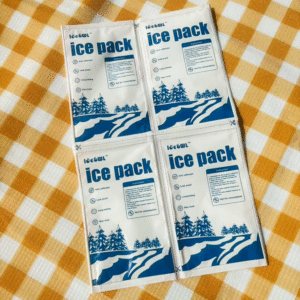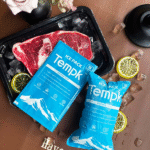When it comes to shipping temperature-sensitive goods, selecting the right cooling solution is crucial. Dry ice and gel packs are the two most popular options. In this article, we will compare both to help you determine which one is best for your specific shipping needs. Let’s explore their differences, benefits, and how each performs for various types of products.

-
What are the key differences between dry ice and gel packs?
-
How does the temperature control of dry ice compare to gel packs?
-
Which one is more cost-effective for long-term shipments?
-
When should you choose dry ice over gel packs?
What Are the Key Differences Between Dry Ice and Gel Packs?
Dry ice and gel packs serve as reliable cold chain solutions but differ significantly in terms of temperature control, duration, and handling. Dry ice, made of solid carbon dioxide, offers extremely low temperatures and sublimes into a gas, leaving no liquid residue. In contrast, gel packs are typically water-based and keep temperatures between 0°C to 10°C, ideal for moderate cooling needs.
Dry Ice:
-
Temperature Range: -78.5°C (-109.3°F)
-
Duration: Long (up to several days)
-
Use: Pharmaceuticals, biological samples, frozen foods
-
Handling: Requires careful packaging and ventilation
Gel Packs:
-
Temperature Range: 0°C to 10°C (32°F to 50°F)
-
Duration: Short to medium (hours to 1-2 days)
-
Use: Fresh produce, dairy, chocolates, medications
-
Handling: Safer and easier to handle
What Are the Advantages of Using Dry Ice Over Gel Packs?
Dry ice is known for its ability to maintain sub-zero temperatures for extended periods. It is the preferred choice for shipments requiring extremely cold conditions, like vaccines, biological samples, and frozen foods.
Key Benefits of Dry Ice:
-
Longer Duration: Dry ice can last for hours or even days without needing replenishment.
-
Sub-zero Temperatures: Keeps products frozen, ideal for pharmaceuticals and foods needing ultra-low temperatures.
-
Space Efficiency: Requires less volume than gel packs for the same cooling effect.
Example: In 2020, dry ice was essential in shipping COVID-19 vaccines worldwide, maintaining the required ultra-low temperatures.
When Should You Choose Gel Packs Over Dry Ice?
Gel packs are a great option when shipping items that need moderate cooling. They are often preferred for non-extreme cooling needs such as chilled food or cosmetics, where the temperatures don’t need to drop below freezing.
Key Benefits of Gel Packs:
-
Safer Handling: Gel packs are easier and safer to manage than dry ice, which requires special handling due to the risk of CO2 buildup.
-
Cost-Effective: Gel packs are generally more affordable, especially for small shipments that don’t need ultra-low temperatures.
-
Regulatory Ease: Gel packs are not classified as hazardous materials, unlike dry ice, which requires additional documentation and handling.
Example: Gel packs are ideal for shipping chocolates or cosmetics that need temperatures above freezing but below room temperature.
Dry Ice vs Gel Packs: Cost Comparison
| Feature | Dry Ice | Gel Packs |
|---|---|---|
| Temperature | -78.5°C (-109.3°F) | 0°C to 10°C (32°F to 50°F) |
| Duration | Long (hours to days) | Moderate (hours) |
| Handling | Requires careful handling | Safe and easy to handle |
| Regulatory Requirements | Strict (hazardous material) | Minimal |
| Cost | High for large quantities | Low, cost-effective |
Real-World Applications and Practical Tips
For Medical Shipments:
-
Use Dry Ice: Ensure sensitive items like vaccines and biological samples stay frozen at required temperatures.
For Food Shipments:
-
Use Gel Packs: For chilled food like fresh produce or dairy products, gel packs provide sufficient cooling at a lower cost.
For Pharmaceuticals:
-
Dry Ice for Ultra-Cold Needs: Use dry ice for temperature-sensitive pharmaceuticals needing sub-zero temperatures.
When to Use Dry Ice for International Shipping?
International shipments often require strict temperature controls and regulations. Dry ice is perfect for long-distance shipping as it maintains low temperatures for extended periods, making it suitable for:
-
Frozen food exports
-
Pharmaceuticals and biological supplies
However, be aware of the regulations for shipping dry ice internationally. Countries often have specific rules regarding dry ice quantities, packaging, and labeling for customs clearance.
2025 Trends in Cold Chain Shipping
Trends Overview:
The cold chain shipping industry is undergoing rapid changes, particularly driven by advancements in smart packaging and sustainability.
Latest Trends:
-
Smart Packaging: IoT-enabled packaging for real-time temperature tracking.
-
Sustainability: Focus on eco-friendly and reusable cold chain solutions.
-
Regulation Changes: Stricter rules on temperature-sensitive shipments, especially for pharmaceuticals.
Frequently Asked Questions
Q1: Which is cheaper, dry ice or gel packs?
Gel packs are generally more affordable, especially for smaller shipments, due to fewer handling requirements and regulatory costs.
Q2: How long do dry ice and gel packs last?
Dry ice can last much longer, up to several days, while gel packs typically last for hours, depending on shipment duration.
Conclusion and Recommendations
Summary:
Dry ice is the ideal choice for shipments requiring extreme cold and longer durations, whereas gel packs offer a safer, more cost-effective solution for moderate cooling needs.
Actionable Steps:
-
For sub-zero temperatures: Choose dry ice, especially for vaccines and pharmaceuticals.
-
For moderate cooling needs: Opt for gel packs to save costs and ensure ease of handling.
About Tempk
At Tempk, we specialize in providing reliable cold chain solutions, including dry ice and gel packs, tailored for industries like pharmaceuticals, food, and medical logistics. Our commitment to innovation ensures your temperature-sensitive products are delivered safely.
Take Action: Contact us for a consultation on enhancing your cold chain shipping solutions.























